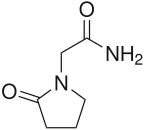Racetam


Racetams are a class of drugs that share a pyrrolidone nucleus.[1][2][3] Many have a 2-oxo-1-pyrrolidine acetamide nucleus. Some racetams, such as piracetam, aniracetam, oxiracetam, pramiracetam, and phenylpiracetam, are considered nootropics.[4] Phenylpiracetam is also a stimulant.[1] Others, such as levetiracetam, brivaracetam, and seletracetam, are anticonvulsants.[5]
Mechanism
[edit]There is no universally accepted mechanism of action for racetams. Racetams generally show negligible affinity for common central nervous system receptors, but modulation of central neurotransmitters, including acetylcholine and glutamate, has been reported. Although aniracetam and nebracetam show some affinity for muscarinic acetylcholine receptors, only nefiracetam demonstrates nanomolar interactions with neurotransmitter receptors. Modification of membrane-located mechanisms of central signal transduction is another hypothesis.[2]
Like some ampakines, some racetams, such as piracetam and aniracetam, are positive allosteric modulators of the AMPA receptor.[6]
Racetams are understood to work by allosterically modulating glutamate receptors, specifically AMPA receptors, leading to Ca2+ influx that is excitatory.[7] Racetams are posited to enhance memory through interaction with glutamate receptors in the central nervous system.
Phenylpiracetam, unique among racetams in being a phenethylamine and stimulant, is an atypical dopamine reuptake inhibitor.[8][9][10][11]
Anticonvulsant racetams, including levetiracetam, brivaracetam, and seletracetam, act as synaptic vesicle glycoprotein 2A (SV2A) ligands.[5] A newer analogue of these agents, padsevonil, is no longer a racetam itself but is much more potent in comparison and interacts with not only SV2A but also synaptic vesicle glycoprotein 2B (SV2B) and synaptic vesicle glycoprotein 2C (SV2C).[5]
Methylphenylpiracetam, a derivative of phenylpiracetam, is a positive allosteric modulator of the sigma σ1 receptor.[9][12][13][14] It is currently the only racetam known to possess this action.[9]
Cofactors
[edit]In studies with aged rats, marked improvement has been observed in cognitive tasks in experimental groups given piracetam. Performance was further increased when piracetam was combined with choline. Evidence in studies with rats has indicated that the potency of piracetam is increased when administered with choline.[15]
List of racetams
[edit]| Structure | Name |
|---|---|
 |
Piracetam |
 |
Oxiracetam |
 |
Phenylpiracetam / Fonturacetam |
 |
Phenylpiracetam Hydrazide / Fonturacetam Hydrazide |
 |
Aniracetam |
 |
Pramiracetam |
 |
Seletracetam |
 |
Levetiracetam |
 |
Coluracetam / BCI-540 |
 |
Fasoracetam |
 |
Brivaracetam |
 |
Dimiracetam |
 |
Methylphenylpiracetam / E1R |
 |
Nebracetam |
 |
Nefiracetam |
 |
Omberacetam / Noopept |
 |
Rolziracetam |
 |
Cebaracetam |
Chemistry
[edit]Racetams are cyclic derivatives of the inhibitory neurotransmitter γ-aminobutyric acid (GABA).[1] They are also structurally related to the endogenous cyclic amino acid pyroglutamic acid (pyroglutamate), a cyclic analogue of the endogenous excitatory neurotransmitter glutamic acid (glutamate).[2][3]
-
γ-Aminobutyric acid (GABA)
-
Glutamic acid (glutamate)
Legality
[edit]Australia
[edit]All racetams are schedule 4 substances in Australia under the Poisons Standard (February 2020).[16] A schedule 4 substance is classified as "Prescription Only Medicine, or Prescription Animal Remedy – Substances, the use or supply of which should be by or on the order of persons permitted by State or Territory legislation to prescribe and should be available from a pharmacist on prescription."[16]
References
[edit]- ^ a b c Malykh AG, Sadaie MR (February 2010). "Piracetam and piracetam-like drugs: from basic science to novel clinical applications to CNS disorders". Drugs. 70 (3): 287–312. doi:10.2165/11319230-000000000-00000. PMID 20166767.
- ^ a b c Gualtieri F, Manetti D, Romanelli MN, Ghelardini C (2002). "Design and study of piracetam-like nootropics, controversial members of the problematic class of cognition-enhancing drugs". Current Pharmaceutical Design. 8 (2): 125–138. doi:10.2174/1381612023396582. PMID 11812254.
- ^ a b Gouliaev AH, Senning A (May 1994). "Piracetam and other structurally related nootropics". Brain Res Brain Res Rev. 19 (2): 180–222. doi:10.1016/0165-0173(94)90011-6. PMID 8061686.
- ^ Cohen, Pieter A.; Zakharevich, Igor; Gerona, Roy (25 November 2019). "Presence of Piracetam in Cognitive Enhancement Dietary Supplements". JAMA Internal Medicine. 180 (3): 458–459. doi:10.1001/jamainternmed.2019.5507. PMC 6902196. PMID 31764936.
- ^ a b c Wu PP, Cao BR, Tian FY, Gao ZB (May 2024). "Development of SV2A Ligands for Epilepsy Treatment: A Review of Levetiracetam, Brivaracetam, and Padsevonil" (PDF). Neurosci Bull. 40 (5): 594–608. doi:10.1007/s12264-023-01138-2. PMID 37897555.
- ^ Ahmed AH, Oswald RE (March 2010). "Piracetam defines a new binding site for allosteric modulators of alpha-amino-3-hydroxy-5-methyl-4-isoxazole-propionic acid (AMPA) receptors". Journal of Medicinal Chemistry. 53 (5): 2197–203. doi:10.1021/jm901905j. PMC 2872987. PMID 20163115.
- ^ Copani A, Genazzani AA, Aleppo G, Casabona G, Canonico PL, Scapagnini U, Nicoletti F (April 1992). "Nootropic drugs positively modulate alpha-amino-3-hydroxy-5-methyl-4-isoxazolepropionic acid-sensitive glutamate receptors in neuronal cultures". Journal of Neurochemistry. 58 (4): 1199–204. doi:10.1111/j.1471-4159.1992.tb11329.x. PMID 1372342.
- ^ Molina-Carballo A, Checa-Ros A, Muñoz-Hoyos A (July 2016). "Treatments and compositions for attention deficit hyperactivity disorder: a patent review". Expert Opin Ther Pat. 26 (7): 799–814. doi:10.1080/13543776.2016.1182989. PMID 27138211.
The racetams have different activities [e.g., phenylpiracetam is a stimulant developed and marketed in Russia, piracetam is a nootropic, and levetiracetam is widely used as an anticonvulsant (Figure 17)].
- ^ a b c Veinberg G, Vavers E, Orlova N, Kuznecovs J, Domracheva I, Vorona M, Zvejniece L, Dambrova M (2015). "Stereochemistry of phenylpiracetam and its methyl derivative: improvement of the pharmacological profile". Chemistry of Heterocyclic Compounds. 51 (7): 601–606. doi:10.1007/s10593-015-1747-9. ISSN 0009-3122.
Phenylpiracetam was originally designed as a nootropic drug for the sustenance and improvement of the physical condition and cognition abilities of Soviet space crews.2 Later, especially during the last decade, phenylpiracetam was introduced into general clinical practice in Russia and in some Eastern European countries. The possible target receptors and mechanisms for the acute activity of this drug remained unclear, until very recently it was found that (R)-phenylpiracetam (5) (MRZ-9547) is a selective dopamine transporter inhibitor that moderately stimulates striatal dopamine release.19
- ^ Sommer S, Danysz W, Russ H, Valastro B, Flik G, Hauber W (December 2014). "The dopamine reuptake inhibitor MRZ-9547 increases progressive ratio responding in rats". The International Journal of Neuropsychopharmacology. 17 (12): 2045–2056. doi:10.1017/S1461145714000996. PMID 24964269.
Here, we tested the effects of MRZ-9547 [...], and its l-enantiomer MRZ-9546 on effort-related decision making in rats. The racemic form of these compounds referred to as phenotropil has been shown to stimulate motor activity in rats (Zvejniece et al., 2011) and enhance physical capacity and cognition in humans (Malykh and Sadaie, 2010). [...] MRZ-9547 turned out to be a DAT inhibitor as shown by displacement of binding of [125I] RTI-55 (IC50 = 4.82 ± 0.05 μM, n=3) to human recombinant DAT expressed in CHO-K1 cells and inhibition of DA uptake (IC50 = 14.5 ± 1.6 μM, n=2) in functional assays in the same cells. It inhibited norepinephrine transporter (NET) with an IC50 of 182 μM (one experiment in duplicate). The potencies for the l-enantiomer MRZ-9546 were as follows: DAT binding (Ki = 34.8 ± 14.8 μM, n=3), DAT function (IC50 = 65.5 ± 8.3 μM, n=2) and NET function (IC50 = 667 μM, one experiment performed in duplicate).
- ^ Stutz PV, Golani LK, Witkin JM (February 2019). "Animal models of fatigue in major depressive disorder". Physiology & Behavior. 199: 300–305. doi:10.1016/j.physbeh.2018.11.042. PMID 30513290.
In a study performed by Sommer et al. (2014), healthy rats treated with the selective dopamine transport (DAT) inhibitor MRZ-9547 (Fig. 1) chose high effort, high reward more often than their untreated matched controls. Unlike similar studies, however, depressive symptoms were not induced before treatment; rather, baseline healthy controls were compared to healthy rats treated with MRZ-9547. [...] In one study, the selective DAT inhibitor MRZ-9547 increased the number of lever presses more than untreated controls (Sommer et al., 2014). The investigators concluded that such effort-based "decision making in rodents could provide an animal model for motivational dysfunctions related to effort expenditure such as fatigue, e.g. in Parkinson's disease or major depression." Based upon the findings with MRZ-9547, they suggested that this drug mechanism might be a valuable therapeutic entity for fatigue in neurological and neuropsychiatric disorders. [...] A high effort bias been reported with bupropion (Randall et al., 2015), lisdexamfetamine (Yohn etal., 2016e), and the DA uptake blockers MRZ-9547 (Sommer et al., 2014), PRX-14040 (Fig. 1) (Yohn et al., 2016d) and GBR12909 (Fig. 1) (Yohn et al., 2016c).
- ^ Vavers E, Zvejniece L, Maurice T, Dambrova M (2019). "Allosteric Modulators of Sigma-1 Receptor: A Review". Front Pharmacol. 10: 223. doi:10.3389/fphar.2019.00223. PMC 6433746. PMID 30941035.
- ^ Zvejniece L, Vavers E, Svalbe B, Vilskersts R, Domracheva I, Vorona M, Veinberg G, Misane I, Stonans I, Kalvinsh I, Dambrova M (February 2014). "The cognition-enhancing activity of E1R, a novel positive allosteric modulator of sigma-1 receptors". Br J Pharmacol. 171 (3): 761–771. doi:10.1111/bph.12506. PMC 3969087. PMID 24490863.
- ^ Vavers E, Zvejniece L, Veinberg G, Svalbe B, Domracheva I, Vilskersts R, Dambrova M (2015). "Novel positive allosteric modulators of sigma-1 receptor". SpringerPlus. 4 (Suppl 1): P51. doi:10.1186/2193-1801-4-S1-P51. PMC 4797911.
The R-configuration enantiomers of methylphenylpiracetam are more active positive allosteric modulators of Sigma-1 receptor than S-configuration enantiomers.
- ^ Bartus RT, Dean RL, Sherman KA, Friedman E, Beer B (1981). "Profound effects of combining choline and piracetam on memory enhancement and cholinergic function in aged rats". Neurobiology of Aging. 2 (2): 105–11. doi:10.1016/0197-4580(81)90007-5. PMID 7301036.
- ^ a b Poisons Standard February 2020. comlaw.gov.au




